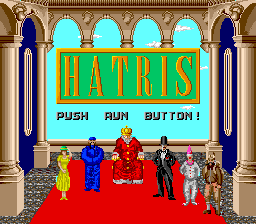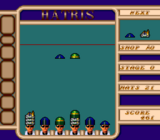Difference between revisions of "Hatris"
From NEC Retro
| (9 intermediate revisions by 2 users not shown) | |||
| Line 2: | Line 2: | ||
| bobscreen=Hatris PCE title.png | | bobscreen=Hatris PCE title.png | ||
| publisher=[[Microcabin]] | | publisher=[[Microcabin]] | ||
| − | | developer=[[Bullet-Proof Software]] | + | | developer=[[ParaGraph]], [[Bullet-Proof Software]] |
| system=[[PC Engine]] | | system=[[PC Engine]] | ||
| − | | players= | + | | players=1 |
| genre=Puzzle | | genre=Puzzle | ||
| releases={{releasesPCE | | releases={{releasesPCE | ||
| Line 11: | Line 11: | ||
| pce_rrp_jp=5,800 | | pce_rrp_jp=5,800 | ||
}} | }} | ||
| + | | otherformats={{NonNEC|Arcade|GB|NES}} | ||
}} | }} | ||
| − | {{ | + | '''''{{PAGENAME}}''''' (ハットリス) is a ''[[Tetris]]'' spinoff puzzle game created by Alexey Pajitnov and Vladimir Pokhilko of [[ParaGraph]]. While known for its release on Nintendo platforms, a [[PC Engine]] version was released exclusively in Japan by [[Microcabin]] in 1991. |
| + | |||
| + | ==Gameplay== | ||
| + | {{ScreenThumb|Hatris PCE Gameplay.png|width=200|Gameplay screenshot.}} | ||
| + | Set within a hat shop, ''Hatris'' is played in a similar fashion to ''Tetris'' in that random hats will fall from the top of the playing field and the player must arrange the hats onto the heads at the bottom to score points and keep the playing field open. Hats fall in pairs, and the player can move the falling hats with {{Left}} and {{Right}} and switch them around with {{I}}. Pressing {{Down}} will instantly drop the hats, with the hat sticking on the tallest stack beneath it while the other hat can be moved to another stack. The hats come in six different kinds, and stack differently based on their shape. | ||
| + | |||
| + | The player must stack five hats of the same kind in a stack to eliminate them and decrease the hat count by one. When 25 sets have been eliminated, the stage is cleared and the player will move on to the next stage. Inbetween stages, a "sale" screen appears and the player is given the option of removing all hats of a particular kind from the playing field. Choosing "PASS" or not making a choice in five seconds will continue the game without removing any hats, and the player will receive bonus points instead. Additionally, once a kind of hat has been cleared via a sale, that same kind cannot be chosen again after a later stage in the same shop. | ||
| + | |||
| + | Another way to clear hats is to place fireballs that periodically appear - a red fireball will burn only one kind of hat at the top of a stack, while a blue fireball will burn the entire stack, however burning hats will not decrease the quota, and crowns cannot be burned. If a stack is allowed to reach the line at the top of the playing field, the game is over. | ||
| + | |||
| + | The game has a total of six shops, each with ten stages, and the player can select their starting stage and shop when starting a new game. When all stages in a shop have been cleared, the player will be encouraged to play a harder shop. Higher number shops begin with random kinds of hats already stacked on the heads, with the number per stack tied to the shop number (e.g. shop 5 has five hats per head). A faster game speed can also be accessed by pressing {{hold|{{Down}}|{{Run}}}} at the title screen. | ||
| + | |||
| + | ===Hats=== | ||
| + | {| class="prettytable" style="" | ||
| + | !rowspan="2"|Hat | ||
| + | !style="width:100px;text-align:center;"|Mountain Hat | ||
| + | !style="width:100px;text-align:center;"|Hiking Hat | ||
| + | !style="width:100px;text-align:center;"|Umbrella Hat | ||
| + | !style="width:100px;text-align:center;"|Top Hat | ||
| + | !style="width:100px;text-align:center;"|Wizard Hat | ||
| + | !style="width:100px;text-align:center;"|Crown | ||
| + | |- | ||
| + | |style="text-align:center;"|{{sprite|Hatris PCE Sprite Hats.png|2|crop_x=0|crop_width=16}} | ||
| + | |style="text-align:center;"|{{sprite|Hatris PCE Sprite Hats.png|2|crop_x=16|crop_width=16}} | ||
| + | |style="text-align:center;"|{{sprite|Hatris PCE Sprite Hats.png|2|crop_x=32|crop_width=16}} | ||
| + | |style="text-align:center;"|{{sprite|Hatris PCE Sprite Hats.png|2|crop_x=48|crop_width=16}} | ||
| + | |style="text-align:center;"|{{sprite|Hatris PCE Sprite Hats.png|2|crop_x=64|crop_width=16}} | ||
| + | |style="text-align:center;"|{{sprite|Hatris PCE Sprite Hats.png|2|crop_x=80|crop_width=16}} | ||
| + | |- | ||
| + | !Points | ||
| + | |style="text-align:center;"|50 | ||
| + | |style="text-align:center;"|80 | ||
| + | |style="text-align:center;"|120 | ||
| + | |style="text-align:center;"|150 | ||
| + | |style="text-align:center;"|200 | ||
| + | |style="text-align:center;"|300 | ||
| + | |- | ||
| + | !Starting stage | ||
| + | |style="text-align:center;"|0 | ||
| + | |style="text-align:center;"|0 | ||
| + | |style="text-align:center;"|0 | ||
| + | |style="text-align:center;"|2 | ||
| + | |style="text-align:center;"|4 | ||
| + | |style="text-align:center;"|7 | ||
| + | |} | ||
| + | |||
| + | ==Versions== | ||
| + | The PC Engine version of ''Hatris'' is largely based off the [[Nintendo Entertainment System]] and [[Game Boy]] versions previously released by [[Bullet-Proof Software]]. Alexey and Vladimir appeared as extra characters in the NES version of the game who would assist the player in various ways after clearing enough hats, whereas they do not appear in this version. [[Video System]] produced an arcade version with slightly different gameplay rules and support for two players. | ||
==Magazine articles== | ==Magazine articles== | ||
| Line 26: | Line 74: | ||
| console=PC Engine | | console=PC Engine | ||
| region=JP | | region=JP | ||
| − | | front=Hatris | + | | front=Hatris jp front.png |
| − | | back= | + | | back=Hatris jp back.png |
| spinemissing= | | spinemissing= | ||
| − | | card= | + | | card=Hatris jp hucard.png |
| cardback= | | cardback= | ||
| − | | manual= | + | | manual=Hatris jp manual.pdf |
| square=yes | | square=yes | ||
}} | }} | ||
| Line 38: | Line 86: | ||
===ROM dump status=== | ===ROM dump status=== | ||
{{romtable| | {{romtable| | ||
| − | {{rom|PCE|sha1=1E2475AE58F1E612591ACA44D742CC6558D75E15|md5=03D5882776B8DAD0DDCEFF42A173D493|crc32=44E7DF53|size= | + | {{rom|PCE|sha1=1E2475AE58F1E612591ACA44D742CC6558D75E15|md5=03D5882776B8DAD0DDCEFF42A173D493|crc32=44E7DF53|size=128kB|date= |source=Card (JP)|comments=|quality=}} |
}} | }} | ||
==References== | ==References== | ||
<references/> | <references/> | ||
| + | |||
| + | {{HatrisOmni}} | ||
| + | {{Tetris}} | ||
Latest revision as of 14:47, 8 March 2024
| Hatris | ||||||||||
|---|---|---|---|---|---|---|---|---|---|---|
| System(s): PC Engine | ||||||||||
| Publisher: Microcabin | ||||||||||
| Developer: ParaGraph, Bullet-Proof Software | ||||||||||
| Genre: Puzzle | ||||||||||
| Number of players: 1 | ||||||||||
| ||||||||||
|
Hatris (ハットリス) is a Tetris spinoff puzzle game created by Alexey Pajitnov and Vladimir Pokhilko of ParaGraph. While known for its release on Nintendo platforms, a PC Engine version was released exclusively in Japan by Microcabin in 1991.
Contents
Gameplay
Set within a hat shop, Hatris is played in a similar fashion to Tetris in that random hats will fall from the top of the playing field and the player must arrange the hats onto the heads at the bottom to score points and keep the playing field open. Hats fall in pairs, and the player can move the falling hats with ← and → and switch them around with Ⅰ. Pressing ↓ will instantly drop the hats, with the hat sticking on the tallest stack beneath it while the other hat can be moved to another stack. The hats come in six different kinds, and stack differently based on their shape.
The player must stack five hats of the same kind in a stack to eliminate them and decrease the hat count by one. When 25 sets have been eliminated, the stage is cleared and the player will move on to the next stage. Inbetween stages, a "sale" screen appears and the player is given the option of removing all hats of a particular kind from the playing field. Choosing "PASS" or not making a choice in five seconds will continue the game without removing any hats, and the player will receive bonus points instead. Additionally, once a kind of hat has been cleared via a sale, that same kind cannot be chosen again after a later stage in the same shop.
Another way to clear hats is to place fireballs that periodically appear - a red fireball will burn only one kind of hat at the top of a stack, while a blue fireball will burn the entire stack, however burning hats will not decrease the quota, and crowns cannot be burned. If a stack is allowed to reach the line at the top of the playing field, the game is over.
The game has a total of six shops, each with ten stages, and the player can select their starting stage and shop when starting a new game. When all stages in a shop have been cleared, the player will be encouraged to play a harder shop. Higher number shops begin with random kinds of hats already stacked on the heads, with the number per stack tied to the shop number (e.g. shop 5 has five hats per head). A faster game speed can also be accessed by pressing HOLD ↓ RUN at the title screen.
Hats
| Hat | Mountain Hat | Hiking Hat | Umbrella Hat | Top Hat | Wizard Hat | Crown |
|---|---|---|---|---|---|---|
| Points | 50 | 80 | 120 | 150 | 200 | 300 |
| Starting stage | 0 | 0 | 0 | 2 | 4 | 7 |
Versions
The PC Engine version of Hatris is largely based off the Nintendo Entertainment System and Game Boy versions previously released by Bullet-Proof Software. Alexey and Vladimir appeared as extra characters in the NES version of the game who would assist the player in various ways after clearing enough hats, whereas they do not appear in this version. Video System produced an arcade version with slightly different gameplay rules and support for two players.
Magazine articles
- Main article: Hatris/Magazine articles.
Physical scans
| NEC Retro Average | ||||||
|---|---|---|---|---|---|---|
|
| 88 | |
|---|---|
| Based on 1 review | |
| PC Engine, JP |
|---|
Technical information
ROM dump status
| System | Hash | Size | Build Date | Source | Comments | |||||||||
|---|---|---|---|---|---|---|---|---|---|---|---|---|---|---|
| ? |
|
128kB | Card (JP) |
References
| Hatris | |
|---|---|
|
Main page | Comparisons | Hidden content | Magazine articles | Reception
| |
| Tetris games (and spin-offs) for NEC systems |
|---|
| Tetris (1988) | Hatris (1991) | Welltris (1992) | Super Tetris 2 + Bombliss (1994) Blockout (1991) |




